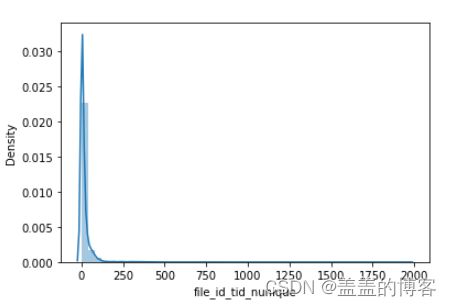阿里云安全恶意程序检测(速通二)
阿里云安全恶意程序检测
- 高阶数据探索
-
- 变量分析
-
- 连续数值变量与连续数值变量
- 单个类别变量与连续数值变量
- 两个类别变量与连续数值变量
- 两个变量线性关系探索
- 查看多个双变量关系的技巧
- 高阶数据探索
-
- 多变量交叉探索
高阶数据探索
变量分析
连续数值变量与连续数值变量
分析连续数值变量和连续数值变量之间的关系,是为了探索变量之间的全局线性、局部
线性的关系等,常用方法: plt.scatter, sns.joinplot (kind= A), A = kde。

单个类别变量与连续数值变量
分析单个类别变量和连续数值变量之间的关系,主要是用于观察不同类别下的连续变量
(常见于回归问题)的分布,如图4-4-2所示。
常用方法: sns.stripplot, sns.swarmplot, sns.boxplot, sns.violinplot。

两个类别变量与连续数值变量
分析两个类别变量和连续数值变量之间的关系,是上述单个类别变量与连续数值变量组
合分析的扩展,用于更深层次的分析,如图4-4-3。常用方法: sns.countplot, sns.barplot, sns. factorplot, sns.pointplot。


两个变量线性关系探索
两个变量线性关系的探索,主要用于分析变量的全局线性、局部线性、其他非线性的关
系,如图4-4-4所示。
常用方法: sns.regplot, sns.mplot, sns.residplot.

查看多个双变量关系的技巧
上面介绍的方法都适用于单独检测,如果我们想直接绘制所有的情况,则在一 一检查时可以考虑查看多个双变量关系的方法,如图4-4-5所示。
常用方法: sns.pairplot, sns. PairGrid.

高阶数据探索
多变量交叉探索
1、通过统计特征file_id_cnt,分析file_id变量和api变量之间的关系
train_analysis = train[['file_id','label']].drop_duplicates(subset = ['file_id','label'],keep = 'last')
dic_=train['file_id'].value_counts().to_dict()
train_analysis['file_id_cnt'] = train_analysis['file_id'].map(dic_).values
train_analysis['file_id_cnt'].value_counts()
sns.displot(train_analysis['file_id_cnt'])

我们发现,API 调用次数的基本上都集中在10 000次以下
2、为了便于分析file_id_cnt变量和label变量之间的关系,首先将数据按file_id_cnt变量也就是API的调用次数取值划分为16个区间
def file_id_cnt_cut(x):
if x < 15000:
return x // 1e3
else:
return 15
train_analysis['file_id_cnt_cut'] = train_analysis['file_id_cnt'].map(file_id_cnt_cut).values
#随机选取4个区间进行查看
plt.figure(figsize = [16,20])
plt.subplot(321)
train_analysis[train_analysis['file_id_cnt_cut'] == 0]['label'].value_counts().sort_index().plot(kind = 'bar')
plt.title('file_id_cnt_cut = 0')
plt.xlabel('label')
plt.ylabel('label_number')
plt.figure(figsize = [16,20])
plt.subplot(321)
train_analysis[train_analysis['file_id_cnt_cut'] == 1]['label'].value_counts().sort_index().plot(kind = 'bar')
plt.title('file_id_cnt_cut = 0')
plt.xlabel('label')
plt.ylabel('label_number')
plt.figure(figsize = [16,20])
plt.subplot(321)
train_analysis[train_analysis['file_id_cnt_cut'] == 14]['label'].value_counts().sort_index().plot(kind = 'bar')
plt.title('file_id_cnt_cut = 0')
plt.xlabel('label')
plt.ylabel('label_number')
plt.figure(figsize = [16,20])
plt.subplot(321)
train_analysis[train_analysis['file_id_cnt_cut'] == 15]['label'].value_counts().sort_index().plot(kind = 'bar')
plt.title('file_id_cnt_cut = 0')
plt.xlabel('label')
plt.ylabel('label_number')
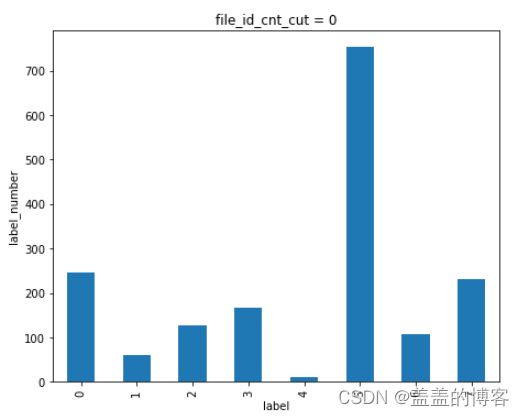
从图中可以看到:当API调用次数越多时,该API是第五类病毒( 感染型病毒)的可能性就越大。
用分簇散点图查看label下file_id_cnt的分布,由于绘制分簇散点图比较耗时,因此采用1000个样本点(2000个所用时间比1000用时多很多)
plt.figure(figsize = [16,10])
sns.swarmplot(x = train_analysis.iloc[:2000]['label'],
y = train_analysis.iloc[:2000]['file_id_cnt'])

从图中得到以下结论:从频次上看,第5类病毒调用API的次数最多;从调用峰值上看,第2类和7类病毒有时能调用150000次的API。
3、首先通过文件调用API的类别数file_id_api_nunique,分析变量file_id和API的关系
dic_=train.groupby('file_id')['api'].nunique().to_dict()
train_analysis['file_id_api_nunique'] = train_analysis['file_id'].map(dic_).values
sns.distplot(train_analysis['file_id_api_nunique'])
train_analysis['file_id_api_nunique'].describe()
文件调用API的类别数绝大部分都在100以内,最少的是1个,最多的是170个。
然后分析file_ id_ api _nunique 和标签label 变量的关系。
train_analysis.loc[train_analysis.file_id_api_nunique >= 100]['label'].value_counts().sort_index().plot(kind='bar')
plt.title('File with api nunique >= 100')
plt.xlabel('label')
plt.ylabel('label_number')
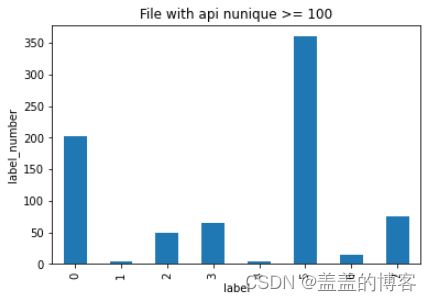
从图中可以发现,第5类病毒调用不同API的次数是最多的。在上面的分析中,我们也发现第5类病毒调用API的次数最多,调用不同API的次数多也是可以理解的。
plt.figure(figsize = [16,10])
sns.boxplot(x=train_analysis['label'],y = train_analysis['file_id_api_nunique'])

从图中得到以下结论:第3类病毒调用不同API的次数相对较多,第2类病毒调用不同API的次数最少;第4,6, 7类病毒的离群点较少,第1类病毒的离群点最多,第3类病毒的离群点主要在下方:第0类和第5类的离群点则集中在上方。
4、首先,通过file_ jid_ index_ nunique 和file_ jid_ index_ max 两个统计特征,分析变量file _id和index之间的关系。有个奇怪的现象,我们发现调用API顺序编号的两个边缘(0 和5001)的样本数是最多的,因此可以单独看一下这两个点的label分布。
#单独看一下API序号为0和5001两个点的label分布
dic_=train.groupby('file_id')['index'].nunique().to_dict()
train_analysis['file_id_index_nunique'] = train_analysis['file_id'].map(dic_).values
train_analysis['file_id_index_nunique'].describe()
dic_=train.groupby('file_id')['index'].max().to_dict()
train_analysis['file_id_index_max'] = train_analysis['file_id'].map(dic_).values
sns.distplot(train_analysis['file_id_index_max'])

从图中可以看出,文件调用index有两个极端:一个是在1附近,另一个是在5000附近。
分析file_id_index_nunique和file_id_index_max与label变量的关系
plt.figure(figsize=[16,8])
plt.subplot(121)
train_analysis.loc[train_analysis.file_id_index_nunique == 1]['label'].value_counts().sort_index().plot(kind = 'bar')
plt.title('File with index nunique = 1')
plt.xlabel('label')
plt.ylabel('label_number')
plt.subplot(122)
train_analysis.loc[train_analysis.file_id_index_nunique == 5001]['label'].value_counts().sort_index().plot(kind = 'bar')
plt.title('File with index nunique = 5001')
plt.xlabel('label')
plt.ylabel('label_number')
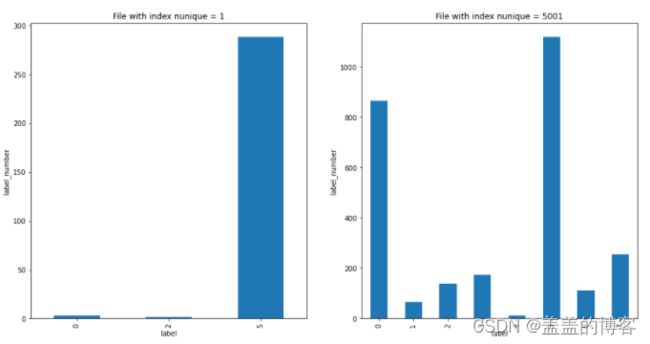
从图中可以发现,在文件顺序编号只有一个时,文件的标签只会是0 (正常)、2 (挖矿程序)或5 (感染型病毒),而不会是其他病毒,而且最大概率可能是5;对于顺序次数大于5000个的文件,其和上面调用API次数很大时类似。
还可以通过绘制小提琴图、分类散点图分析,代码和结果如下:
plt.figure(figsize = [16,10])
sns.violinplot(x = train_analysis['label'],
y = train_analysis['file_id_api_nunique'])
plt.figure(figsize = [16,10])
sns.stripplot(x = train_analysis['label'],
y = train_analysis['file_id_index_max'])
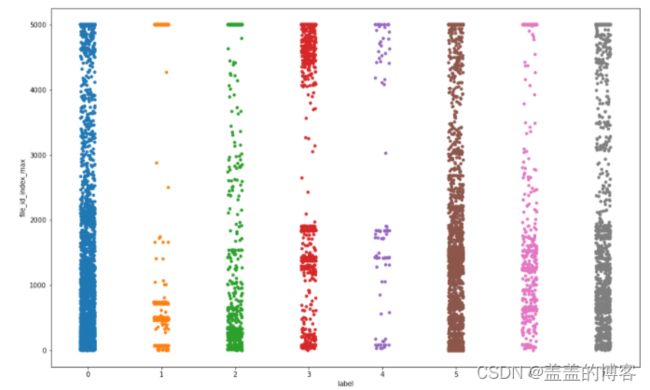
从图中得到的结论:第3类病毒调用不同index次数的平均值最大;第2类病毒调用不同index次数的平均值最小:第5,6, 7类病毒调用不同index次数的平均值相似。
5、首先通过file_ id_ tid_ nunique和file id_ tid max两个统计特征,分析变量file_ id和tid
之间的关系。
dic_= train.groupby('file_id')['tid'].nunique().to_dict()
train_analysis['file_id_tid_nunique'] = train_analysis['file_id'].map(dic_).values
train_analysis['file_id_tid_nunique'].describe()
sns.distplot(train_analysis['file_id_tid_nunique'])
dic_= train.groupby('file_id')['tid'].max().to_dict()
train_analysis['file_id_tid_max'] = train_analysis['file_id'].map(dic_).values
train_analysis['file_id_tid_max'].describe()
sns.distplot(train_analysis['file_id_tid_max'])
#分析file_id_tid_nunique和file_id_tid_max与label变量的关系
plt.figure(figsize=[16,8])
plt.subplot(121)
train_analysis.loc[train_analysis.file_id_tid_nunique < 5]['label'].value_counts().sort_index().plot(kind = 'bar')
plt.title('File with tid nunique < 5')
plt.xlabel('label')
plt.ylabel('label_number')
plt.subplot(122)
train_analysis.loc[train_analysis.file_id_tid_nunique >= 20]['label'].value_counts().sort_index().plot(kind = 'bar')
plt.title('File with tid nunique >= 20')
plt.xlabel('label')
plt.ylabel('label_number')
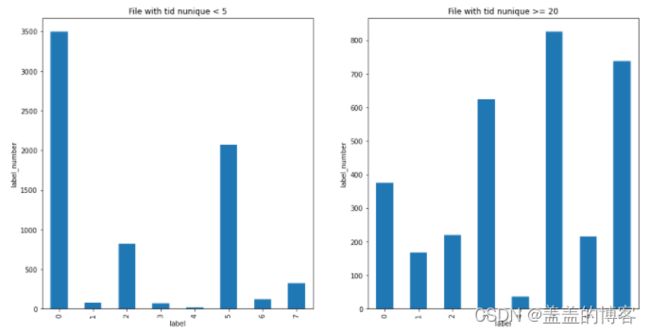
其中,0:正常文件; 1:勒索病毒; 2:挖矿程序; 3: DDoS木马; 4:蠕虫病毒; 5:感
染型病毒; 6:后门程序; 7:木马程序。
还可以通过箱线图和小提琴图进一一步 分析。
plt.figure(figsize = [12,8])
sns.boxplot(x = train_analysis['label'],
y = train_analysis['file_id_tid_nunique'])
plt.figure(figsize = [12,8])
sns.violinplot(x = train_analysis['label'],
y = train_analysis['file_id_tid_nunique'])
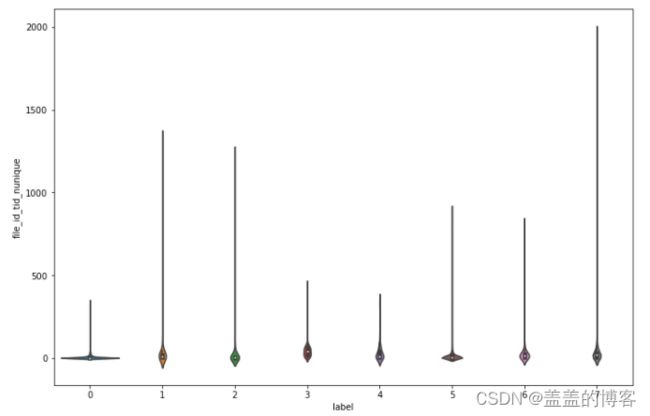
分析file_id和tid的max特征,我们将tid最大值大于3000的数据和整体作比较,发现差异不是很大
plt.figure(figsize=[16,8])
plt.subplot(121)
train_analysis.loc[train_analysis.file_id_tid_max >= 3000]['label'].value_counts().sort_index().plot(kind = 'bar')
plt.title('File with tid max >= 3000')
plt.xlabel('label')
plt.ylabel('label_number')
plt.subplot(122)
train_analysis['label'].value_counts().sort_index().plot(kind = 'bar')
plt.title('All Data')
plt.xlabel('label')
plt.ylabel('label_number')
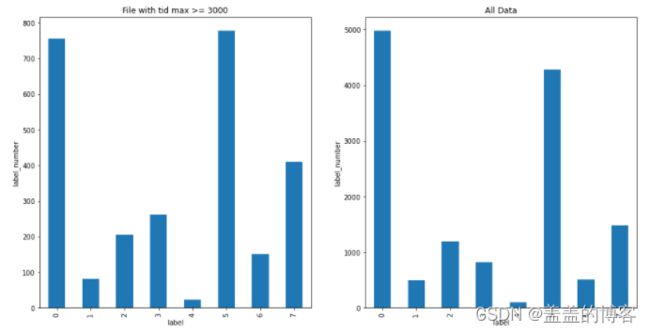
从图中得出的结论:所有文件调用的线程都相对较少;第7类病毒调用的线程数的范围最大;第0类,3类和4类调用的不同线程数类似。
7、分析API变量与label变量的关系,代码及运行结果如下:
train['api_label'] = train['api'] + '_' + train['label'].astype(str)
dic_ = train['api_label'].value_counts().to_dict()
df_api_label = pd.DataFrame.from_dict(dic_,orient = 'index').reset_index()
df_api_label.columns = ['api_label','api_label_count']
df_api_label['label'] = df_api_label['api_label'].apply(
lambda x:int(x.split('_')[-1]))
labels = df_api_label['label'].unique()
for label in range(8):
print('*' * 50,label,'*' * 50)
print(df_api_label.loc[df_api_label.label == label].sort_values(
'api_label_count').iloc[-5:][['api_label','api_label_count']])
print('*' * 103)
从结果可以得到以下结论: LdrGetProcedureAddress, 所有病毒和正常文件都是调用比较多的;第5类病毒: Thread32Next调用得较多;第6类和7类病毒: NtDelayExecution 调用得较多;第2类和7类病毒: Process32NextW 调用得较多。





